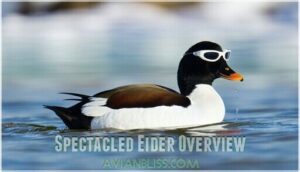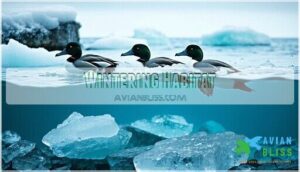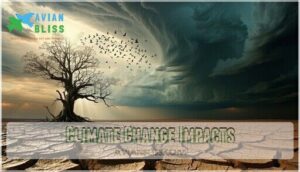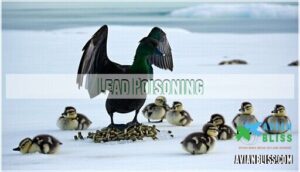This site is supported by our readers. We may earn a commission, at no cost to you, if you purchase through links.

These hardy Arctic birds breed on coastal tundra before making epic migrations to winter in Bering Sea ice openings, diving 200 feet deep for shellfish.
Their population has crashed over 90% since the 1970s due to habitat loss, climate change melting critical sea ice, and lead poisoning from old ammunition.
Now protected under the Endangered Species Act, they’re fighting extinction through strict hunting bans and international conservation efforts.
The spectacled eider’s story reveals surprising secrets about Arctic survival and human impact.
Table Of Contents
- Key Takeaways
- Spectacled Eider Overview
- Spectacled Eider Habitat
- Reasons for Endangerment
- Conservation Efforts
- Hunting Regulations
- Frequently Asked Questions (FAQs)
- What is a spectacled eider?
- Where do spectacled eiders live?
- When was the spectacled eider first described?
- Are spectacled eiders social birds?
- What does a spectacled eider eat?
- How do you identify a spectacled eider?
- Why is the spectacled eider endangered?
- Can you hunt spectacled eiders?
- What is the best time of year to see spectacled eiders?
- Can you hunt spectacled eider?
- Conclusion
Key Takeaways
- You’ll recognize spectacled eiders by males’ distinctive white "goggles" outlined in black around bright orange eyes, making them instantly identifiable among Arctic waterfowl.
- You’re witnessing one of nature’s most catastrophic population crashes – these ducks declined over 96% since the 1970s due to lead poisoning, habitat loss, and climate change melting critical sea ice.
- You can’t legally hunt spectacled eiders since they’re federally protected under the Endangered Species Act as a threatened species with zero bag limits.
- You’ll find these hardy Arctic survivors make epic migrations from Alaskan tundra breeding grounds to Bering Sea ice openings, where they dive 200 feet deep for shellfish during winter.
Spectacled Eider Overview
You’ll recognize the spectacled eider (Somateria fischeri) by the male’s distinctive white "goggles" outlined in black and bright orange bill during breeding season.
This threatened Arctic duck species belongs to the eider genus and faces a 96% population decline since the 1970s, making it one of Alaska’s most endangered waterfowl.
This Arctic duck’s dramatic 96% population crash since the 1970s makes it Alaska’s most endangered waterfowl species.
Scientific Classification
What makes you think of a bird when you hear "Somateria fischeri"?
This spectacled eider belongs to the Eider Genus within the Anatidae Family, sharing taxonomic classification with all waterfowl in the Anseriformes order.
Scientists use this species definition to guarantee classification accuracy when studying these remarkable Arctic ducks.
The Anatidae encompasses ducks, geese, and swans, while the spectacled eider’s taxonomic history reflects decades of careful research distinguishing it from related eider species.
Physical Characteristics
You’ll notice the spectacled eider shows striking differences between males and females.
Males reach about 53 centimeters in length with brilliant white facial markings and yellow-orange bills, while females are smaller at 50 centimeters.
Female plumage appears mottled brown with distinctive pale brown eye patches.
Both sexes share the characteristic long sloping foreheads that help identify this endangered eider duck species.
Observing their body proportions further aids in accurate species identification.
Distinctive Features
You’ll spot this arctic bird by its trademark "goggles" – white eye patches rimmed in black on males during breeding season.
Male plumage features brilliant orange bill coloration and striking white facial markings, while female markings include subtle pale brown eye patches year-round.
Size differences are minimal between sexes, but the Spectacled Eider’s distinctive facial features make this Alaskan bird unmistakable among sea duck species.
Spectacled Eider Habitat
You’ll find spectacled eiders living in some of Earth’s most remote locations, from the marshy tundra of Alaska and Russia where they breed to the icy waters of the Bering Sea where they spend their winters.
These hardy ducks follow an incredible migration pattern that takes them thousands of miles between their summer breeding grounds and winter hideouts among floating sea ice.
Breeding Grounds
You’ll discover Spectacled Eider Arctic breeding grounds across the wet tundra regions of Alaska and Russia.
Their breeding habits center on marshy wetlands where Nesting Ecology thrives in specific conditions.
Key Spectacled Eider breeding locations include:
- Yukon-Kuskokwim Delta and Arctic Coastal Plain in Alaskan tundra
- Northeast Russian tundra wetlands
- Shallow water habitats supporting Chick Survival
Parental Care begins when pairs arrive in late May, with females selecting nest sites in Tundra Wetlands that provide protection and food access for their young.
Wintering Habitat
Beyond the breeding grounds, you’ll find spectacled eiders facing their toughest survival challenge in Bering Sea polynyas.
These threatened diving ducks depend entirely on sea ice openings for wintering habitat, where prey availability determines their fate.
Understanding the importance of wetland conservation efforts is vital for protecting these habitats.
| Habitat Feature | Location | Climate Impact |
|---|---|---|
| Polynya ecology | St. Lawrence to St. Matthew Islands | Sea ice reduction |
| Diving depth | 2-45km offshore | Altered prey distribution |
| Eider habitat density | Large flocks, small areas | Increased vulnerability |
Migration Patterns
Following their ancient GPS, spectacled eiders navigate complex migration routes between Arctic breeding grounds and Bering Sea wintering areas.
You’ll find these Arctic birds using specific stopover sites in Norton Sound and coastal Alaska, where changing sea ice conditions affect their seasonal timing.
Climate impacts alter traditional patterns, forcing adjustments to routes that maintain genetic connectivity across populations through marine ecology dependencies. One can find migration related products online, which may help understand spectacled eider migration.
Reasons for Endangerment
You’re witnessing one of nature’s most dramatic population crashes, as spectacled eiders have declined by over 96% since the 1970s due to multiple threats working against them.
You’re watching one of nature’s most catastrophic collapses unfold in real time.
From lead poisoning to habitat destruction, these Arctic ducks face a perfect storm of challenges that pushed them onto the endangered species list, specifically due to a combination of threats including habitat destruction.
Habitat Loss and Degradation
You’ll witness devastating habitat loss as the spectacled eider’s world shrinks dramatically.
Tundra disturbance from industrial impacts has fragmented their breeding grounds, while coastal erosion destroys nesting sites.
This threatened species faces prey depletion as wetlands dry up, making habitat fragmentation worse.
The population decline stems from these cumulative losses across their range, highlighting urgent conservation needs for this endangered species.
Their numbers have suffered a 96% decline since 1957.
Climate Change Impacts
Climate change threatens this Arctic wildlife like a perfect storm hitting their world.
Shrinking sea ice reduces food availability and alters habitat, while warming waters bring species competition from expanding fish populations.
These changes directly impact breeding success as thawing permafrost drains nesting wetlands.
Population decline accelerates when threatened species face such extensive habitat alteration across their entire range.
Survival rates are affected by extreme ice conditions, impacting the species’ ability to thrive in a world with shrinking sea ice and warming waters.
Hunting and Overharvesting
While climate impacts threaten spectacled eiders, you’ll find that hunting and overharvesting dealt devastating historical blows.
Commercial hunting peaked in the early 1900s, creating sharp population declines that echo today.
Historical overharvest created lasting damage through:
- Subsistence hunting removing up to 3,000 birds annually from Yukon-Kuskokwim Delta populations
- Illegal poaching accounting for 30% of total take in remote habitats
- Population decline exceeding 90% between 1970-1992 in western Alaska
- Harvest management now requiring strict moratoriums for recovery
Today’s bird conservation efforts focus on sustainable hunting practices, but population impact from past overharvest still haunts recovery efforts.
Lead Poisoning
Lead poisoning strikes spectacled eiders when they ingest spent lead shot while feeding.
This toxic metal accumulates in their systems, causing neurological damage and death. Research shows 24.3% of breeding females still carry dangerous lead levels despite hunting restrictions.
Diving ducks like Stellers Eider face similar threats. Mitigation strategies include non-toxic ammunition requirements, while future research focuses on contamination sources affecting these vulnerable duck species across Arctic habitats.
Switching to safer ammunition types can substantially reduce lead exposure.
Conservation Efforts
Scientists aren’t giving up on the spectacled eider, even though this Arctic duck’s numbers crashed by over 96% in just two decades.
You’ll find multiple conservation strategies working together to pull this threatened species back from the brink, from habitat protection and lead poisoning prevention to international research partnerships that span Alaska and Russia.
Recovery Plans
Federal agencies launched thorough recovery plans for the spectacled eider following its 1993 endangered species listing.
These strategic blueprints guide conservation efforts through adaptive management, ensuring funding allocation targets the most critical threats facing these Arctic birds.
- Plan Effectiveness: Recovery benchmarks track population trends and breeding success rates
- Funding Allocation: Resources prioritize lead reduction, habitat restoration, and monitoring programs
- Adaptive Management: Scientists adjust strategies based on real-time population data
- Community Involvement: Indigenous partnerships strengthen conservation through traditional knowledge
- Future Strategies: Updated criteria establish clear delisting requirements for threatened species management
Habitat Protection
You’ll find that habitat protection forms the backbone of spectacled eider conservation efforts across Alaska’s fragile Arctic landscape.
Protected Areas like the Yukon Delta National Wildlife Refuge safeguard critical breeding grounds, while Coastal Management strategies shield nesting sites from Industrial Impact.
The IUCN emphasizes Habitat Restoration projects that rebuild damaged wetlands, creating Climate Resilience against warming temperatures that threaten these specialized ducks’ survival.
Protecting these species involves migratory bird conservation to guarantee their continued survival, focusing on conservation efforts.
Research Initiatives
Multiple research projects track spectacled eiders using satellite transmitters and telemetry studies to understand their movements.
Scientists conduct genetic research, population modeling, and diet analysis to assess breeding success rates.
Contaminant effects research examines lead poisoning impacts on survival.
Bird tracking through satellite telemetry has mapped seven critical habitat areas, providing essential data for conservation planning efforts.
Researchers can purchase telemetry related products for tracking.
International Collaboration
You’ll find that spectacled eider protection requires teamwork across borders.
The Arctic Council coordinates transboundary conservation efforts while Migratory Bird Treaties guide international policies.
Researchers share data on migration patterns, creating a unified approach to arctic wildlife protection.
This collaborative research helps scientists track the same migratory bird populations across Alaska and Russia, strengthening bird conservation efforts worldwide.
Hunting Regulations
You can’t legally hunt spectacled eiders in the United States since they’re protected under the Endangered Species Act.
All hunting of this threatened species is strictly prohibited, with serious federal penalties for violations.
Current Laws
Spectacled eiders receive robust protection through the ESA listing as threatened species, managed by the US Fish and Wildlife Service.
The Migratory Bird Treaty Act provides additional MBTA protections, while state regulations complement federal oversight.
However, enforcement challenges persist across remote Arctic breeding grounds, making wildlife conservation difficult for these endangered birds.
Future legislation may strengthen protections.
Permits and Licenses
Hunting spectacled eiders requires traversing a complex web of permits since they’re protected under federal law.
You can’t simply grab your gear and head out – the Application Process demands specific documentation for bird research projects or approved bird conservation efforts.
License Requirements vary by state, but Regulatory Compliance remains strict nationwide.
Enforcement Penalties for violating bird status protections can devastate your wallet and reputation, especially given declining bird population concerns.
Bag Limits
You can’t hunt spectacled eiders legally—bag limits are set at zero for this threatened waterfowl species. This rare bird receives complete protection under federal law, though subsistence hunters face unique challenges.
Traditional bag limit history shows how adaptive management helped other duck populations recover, but enforcement challenges remain significant.
Current regulations prioritize population recovery over harvest opportunities, reflecting the species’ critical conservation status and need for specialized bird identification skills among wildlife managers.
Creating a bird-friendly backyard can also help support these vulnerable species.
Enforcement Measures
Federal agencies don’t mess around when protecting this rare Arctic bird species.
Monitoring compliance happens year-round through specialized waterfowl enforcement teams who track violations and assess penalties.
Here’s how regulatory effectiveness works:
- Officers conduct field surveillance during hunting seasons
- Penalties assessed range from $100,000 fines to equipment seizure
- Funding allocation supports dedicated enforcement personnel
- Public awareness campaigns educate hunters about ducks protection laws
The enforcement process is thorough, with specialized waterfowl enforcement teams working to ensure compliance and protect the species.
Frequently Asked Questions (FAQs)
What is a spectacled eider?
Over 96% of Alaska’s spectacled eiders vanished between the 1970s and 1990s.
You’re looking at a threatened Arctic duck with distinctive white "goggles" that winters in Bering Sea ice gaps, diving for clams while facing lead poisoning threats.
Where do spectacled eiders live?
You’ll find these remarkable ducks breeding on Alaskan and Russian tundra during summer, then migrating to winter among sea ice gaps in the Bering Sea’s frigid waters.
When was the spectacled eider first described?
You’ll discover the scientific naming story dates to 1847 when German naturalist Johann Friedrich von Brandt first described this Arctic duck . Originally called Fischer’s eider, honoring German paleontologist Fischer.
Are spectacled eiders social birds?
Yes, you’ll find spectacled eiders are highly social birds.
They congregate in massive, dense flocks during winter and migrate together through spring and fall in smaller groups of fewer than fifty individuals.
What does a spectacled eider eat?
You’ll find they’re versatile feeders who adapt their diet seasonally.
During breeding, they dabble for insects and plant seeds in shallow tundra ponds, then dive for clams and marine invertebrates in winter seas.
How do you identify a spectacled eider?
Forget binoculars—you’ll spot these Arctic ducks by their unmistakable "spectacles."
Look for males’ bright white eye patches outlined in black, plus orange bills and white backs.
Females sport subtle brown eye patches on mottled brown plumage, which is a key distinguishing feature of these ducks, along with their orange bills.
Why is the spectacled eider endangered?
Population crashes devastate this Arctic duck species.
You’ll find their numbers plummeted over 96% since the 1970s due to lead poisoning, habitat loss, predation, and climate change affecting their specialized sea-ice wintering areas.
Can you hunt spectacled eiders?
No, you can’t hunt spectacled eiders.
They’re federally protected under the Endangered Species Act, making hunting them illegal.
Their threatened status means strict regulations prohibit taking these birds anywhere in their range, and this protection is crucial for their survival under the Endangered classification.
What is the best time of year to see spectacled eiders?
Like a bird watching clock marking time’s passage, you’ll spot spectacled eiders best during late May through September.
When they’re nesting and raising young on Alaskan tundra, especially around the Yukon-Kuskokwim Delta area.
Can you hunt spectacled eider?
No, you can’t hunt spectacled eiders.
They’re protected under the Endangered Species Act as a threatened species, making hunting them illegal.
Their population crashed dramatically, declining over 96% since the 1970s, necessitating strict federal protection.
Conclusion
Ironically, you’d think a duck with built-in "goggles" would see trouble coming, yet the spectacled eider missed the warning signs of its own decline.
You’ve learned how these remarkable Arctic survivors face extinction despite their incredible adaptations for harsh polar conditions.
The spectacled eider’s future depends entirely on your generation’s commitment to climate action and habitat protection.
Without immediate conservation efforts, these white-goggled wonders might disappear forever from Alaska’s coastal waters.












